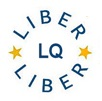Paper and digital repositories in the United States
DOI:
https://doi.org/10.18352/lq.7738Abstract
What you've asked me to talk about today is basically what can libraries do with all the stuff they have and continue to get. Where do we put it all; what do we do with it? As we know, libraries have three core functions: collecting, organizing and preserving the key documents of the human enterprise. And, with apologies to Saint Paul, the greatest of these is preservation. For without preservation neither of the first two ultimately matter. My assignment this morning is to bring you up to date on one specific aspect of the preservation function, library repositories, and indeed, library repository developments in the US. The plan for this morning's presentation is the following: after a brief background review to give us a context for American developments we will examine first the various kinds of print repositories and then the various initiatives for electronic repositories. Because other presentations at this conference deal with electronic repositories, the main focus today will be on U.S. print repositories.Downloads
Download data is not yet available.

Published
2003-09-22
Issue
Section
Articles
License
Copyright (c) 2003 David F. Kohl

This work is licensed under a Creative Commons Attribution 4.0 International License.
How to Cite
Paper and digital repositories in the United States. (2003). LIBER Quarterly: The Journal of the Association of European Research Libraries, 13(3-4). https://doi.org/10.18352/lq.7738





